As Peer Gynt reminisces with his dying mother, they dwell long and fondly on how, when Peer was a child, they would imagine his bed was a sleigh whisking them across a frozen fjord, a sleigh pulled by "fleet-foot horses".
Or more accurately by a cat proxying for fleet-foot horses; a cat who before being pressed into service as a horse had been peacefully "sad på en kubbestol"1, sat upon a kubbestol: a chair hewn from a tree trunk, and an item of furniture which is as closely associated with Norway as is Peer Gynt, and which may have led just have as many lives and have just as many tales to tell.....
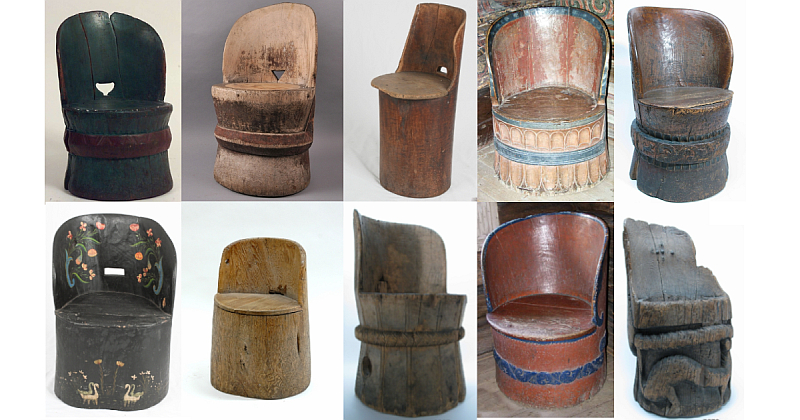
Whereby the first thing to note is that the kubbestol isn't singular to Norway, it is also Swedish, the kubbstol.2
And the second thing to note is that it is not certain that it originated in either Norway or Sweden, but may be Italian. Which would be fitting as Henrik Ibsen was in Italy when he wrote Peer Gynt.
But let us start at the beginning......
......or more accurately, let us start with the earliest records of the kubbestol/kubbstol in Scandinavia. And which the archaeologist, and one time Director of the Statens historiska museum, Stockholm, Bernhard Salin understands in the form of small silver amulets: one from a burial site on the island of Björkö to the west of Stockholm, and which Salin dates as 9th century, and two found amongst a collection of money and jewellery unearthed at Fölhagen on the Swedish island of Gotland and dated by Salin to the 10th century.3 Three small silver amulets which bear an uncanny similarity4, and which are kept today by the Statens historiska museum, alongside several other amulets depicting kubbstolar. Possibly depicting kubbstolar. Amulets one is happy to let oneself be convinced depict kubbstolar. And of which one of the most convincing depictions is an example dated 800 - 1099, also from Björkö, and which has a much longer base than the three Salin quotes. In addition to silver amulets the Statens historiska museum also has two in amber, one each from Björkö and Gotland.5
Whereby it is important to remember that a representation of a kubbstol created in 9th and/or 10th century Sweden shouldn't be confused with the physical existence of the kubbstol in 9th and/or 10th century Sweden. That while it strongly implies they almost certainly were physically in existence in Sweden; they alone confirm that kubbstolar were known in Sweden, and presumably had an importance and significance. Or why use them as amulets, and as amulets crafted from precious, valuable, materials?6
In 1916 Bernhard Salin noted that "due to lack of time and space, I have to refrain from considering the interesting question of why the kubbstol during the Viking Age was made in the form of a pendant."7
For us that isn't a skippable question. It's not just an interesting question, but an important question.
One possible answer to which could be found on a carving originating from the Sanda churchyard, also on Gotland, and similarly dated 800-1099 CE. Or can be found on the Sanda carving if one follows the interpretation of Hugo Junger, who argues that the enclosed space in which the three figures in the top part of the carving find themselves, is Valhalla, that famed residence where slain, and favoured, Nordic warriors enjoyed the afterlife, the figure seated on the right is Odin, the principle God of Norse mythology and Lord of Valhalla, the seated figure on the left, the Goddess Frigg, wife of Odin and Lady of Valhalla.8 Junger goes on to interpret the scene in more detail, including the important question of why the trio appear to be under attack from an enormous duck; however, our interest is served by the interpretation of Valhalla, Odin and Frigg, and that whereas Odin's chair is only decipherable with an excellent, and biased, imagination, Frigg's chair is very clearly a kubbstol. And if Frigg and Odin furnished Valhalla, or perhaps just their private rooms and/or the public reception rooms, with kubbstolar, then that not only makes the kubbstol one of the original seats of power, but bequeaths the kubbstol an importance and significance that justifies amulets crafted from precious, valuable, materials.
Exactly what that significance is and was, other than, potentially, a simple symbol of the power of Odin and/or Frigg, we know no9; the amulets remaining as Hans Hildebrand once described the Fölhagen amulets, "small object[s] of unknown purpose".10 But an argument linking them to Valhalla is certainly one that can be made.11
And if made, and accepted, raises the question, who introduced Frigg and Odin to the kubbstol?
Which is, in effect, the same question as that of the origins of the kubbestol/kubbstol......
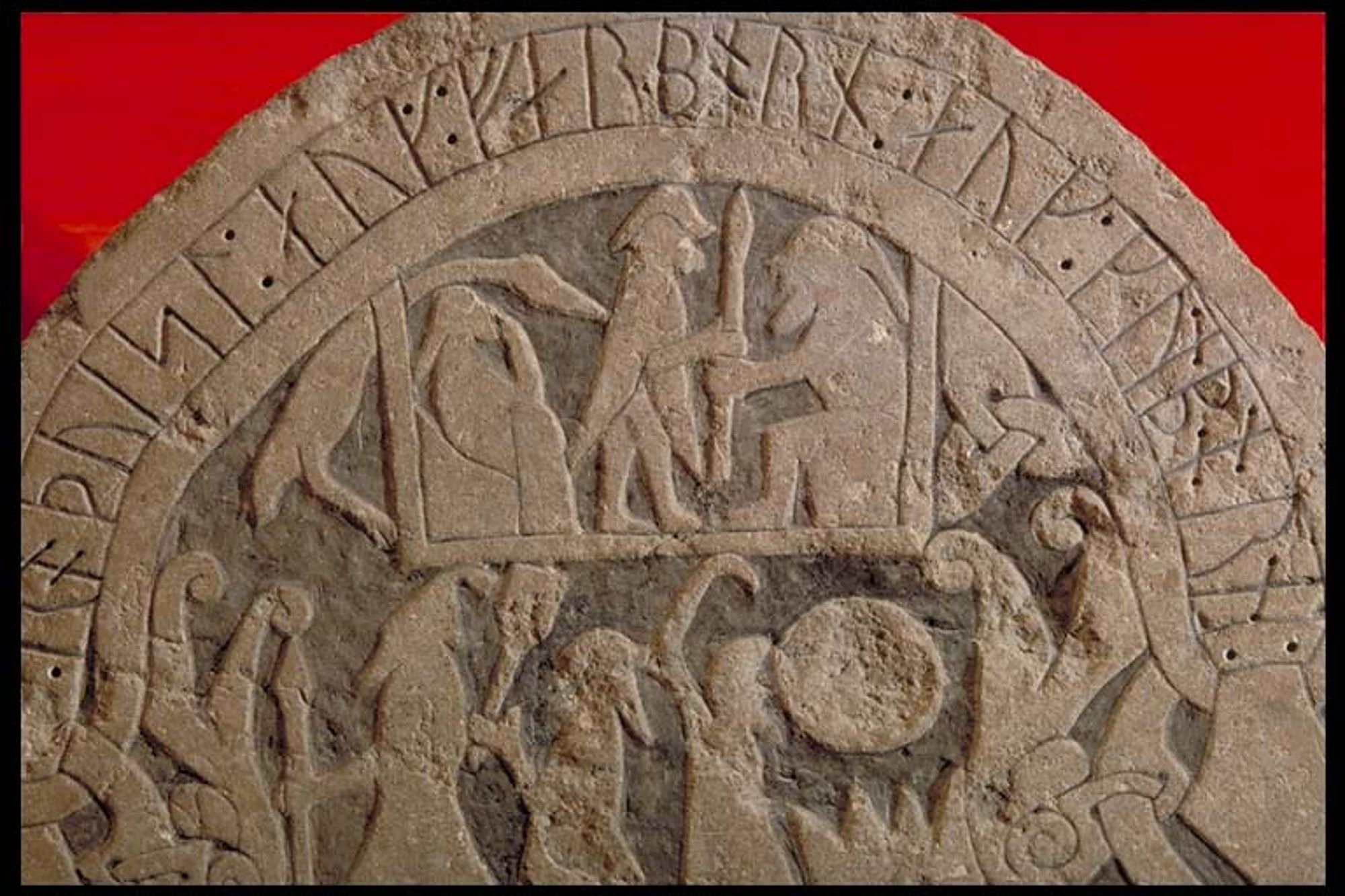
And a question whose answer is: nobody knows.
As with all items of vernacular furniture the search for origins invariably leads one to supposition and fantasy, rather than your actual facts; that our considerations on the kubbestol/kubbstol have thus far have brought us to Asgard and the realms of Norse mythology being both apposite and symbolic.
And may also bring us a little closer to an answer.
Or may see us getting ever more lost in supposition and fantasy.
Whereas the earliest known kubbestol/kubbstol in Scandinavia are in the form of jewellery and carvings, in ancient contemporary Italy, one finds actual chairs of a very similar type: Bentini et al12, for example, noting that in burial sites in Verucchio in Italy's Emilia-Romagna region, and believed to date from between the 9th and 7th centuries BCE, some 16 wooden thrones have been identified, wooden thrones featuring a "cylindrical base and a curved backrest" and all "made out of a single tree trunk, carved into shape and then decorated"13, and which formally have an undeniable resemblance to the later Scandinavian models.
Bentini et al also noting that on account of the use of ornate decoration on the inner surfaces, so where one sits, rather than on the exterior surfaces, that the objects were, in all probability not intended for use in life but rather, "made exclusively for the funeral ritual and burial".14 And for all were created for the banquet that was symbolically laid out for the deceased in their tomb, a, by all accounts, regular component of the funeral ritual at that time in Villanovan culture, and which saw tombs furnished with not just chairs but tables and all the accoutrements necessary for dining.15 And whereas the Verucchio chairs, and other similar finds, are large enough for humans to sit in, elsewhere in northern Italy, for example in Chiusi, now Tuscan, then Etruscan, one finds smaller chairs of a very similar kind and on which sat urns with the cremated ashes of the deceased.16 Again in context of a banquet and complete with not just chairs but tables, crockery, etc...
And thus whether full size or miniature were very much chairs created for use by the deceased in the afterlife.
Which could bring us back to Odin and Frigg, and who, possibly, acquired their inspiration for the furnishing of Valhalla from the Etruscans/Villanovans, and thereby bringing the tree trunk chair to Scandinavia.
One just has to bridge a gap of some 1500 - 2000 years. Most of the European continent. And an awful lot of inter-related and antagonistic civilisations and cultures.
But can one?
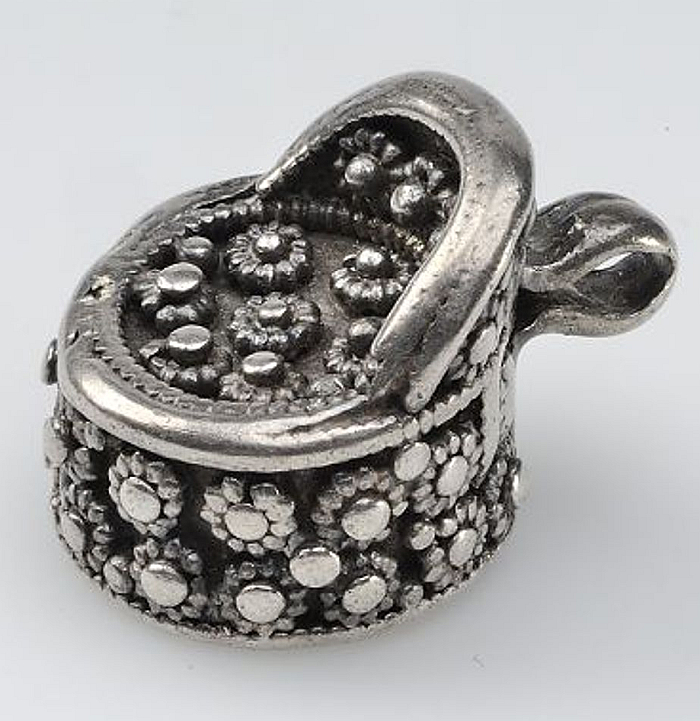
In 1916 Bernhard Salin asked, "Huru förhålla sig nu de etruskiska kubbstolarna till de norska?"17,"How do the Etruscan log chairs relate to the Norwegian ones?", and proposed three possible answers: (a) pure chance, i.e. no relationship between developments in Italy and developments in Scandinavia; (b) a "fortlöpande tradition", an ongoing tradition, a continual, and ever developing transfer of ideas, understandings and approaches across time and geography; or (c) an innate, universal understanding of formal beauty amongst the human species that naturally leads to the same solution for the same problem in different locations.
Briefly pondering the three Salin replies that "with the material now available to me, it is impossible to answer these questions". A century and a bit later it's not much easier for us to offer a more definite answer.
Whereby a century and a bit later, it should be.
Since Salin considered the question not only have our understandings of Vikings, Etruscans and Villanovans improved considerably, but also our understandings of the millennia between the graves at Verucchio/Chiusi and those on Gotland/Björkö; we now have a much better, if still incomplete, understanding of the complex developments which arose through the movements of peoples, evolving trading relationships, ongoing wars, etc.
And we also have, which Bernhard Salin and his contemporaries didn't have, a tree trunk chair discovered in the first centuries CE Saxon burial site at Fallward near Wremen on the German North Sea coast.18 A tree trunk chair not only associated with a burial, but which, as with the Verucchio examples, features ornate carvings on the interior of the backrest, ornate carvings which, again as with the Verucchio examples can, arguably, be considered symbolic of the deceased, a representation of whomever was intended to sit in the chair. And a carved tree trunk chair associated not just with a burial, but with a ship burial; a form of burial not known in BCE Italy but known in CE Scandinavia. And thus a carved tree trunk chair which has parallels to the Etruscan/Villanovan examples yet which is far enough away from them to imply but an indirect influence, an influence that had passed through many hands on its journey, and is simultaneously close enough to the Gotland/Björkö amulets to imply a much more direct link.
And thus a "fortlöpande tradition"?
As far as we can ascertain, no one has attempted to unravel such19, although it would appear a task well worth undertaking, and one that may very well map a conclusive, if not direct, path from Italy to Scandinavia. However until that path is mapped, it remains theoretical.
The current realities mean that, much as we wanted to, we couldn't even begin to approach attempting to map such a path, the sources and resources we would need being every bit as temporarily outwith our reach as the countries we would need to visit.
Not that we would expect to complete the proposed path, the point of travelling isn't arriving but discovering, learning, experiencing; and logical as the "fortlöpande tradition" appears to be on the basis of that which we do have, and as satisfying as the movements of people throughout Europe bringing, arguably, not only the tree trunk chair, but also Odin, from Italy to Scandinavia, unquestionably is, we tend more towards the pure chance option Bernhard Salin rejected out of hand.
Our principle problem being the reasons for the tree trunk chairs existences.
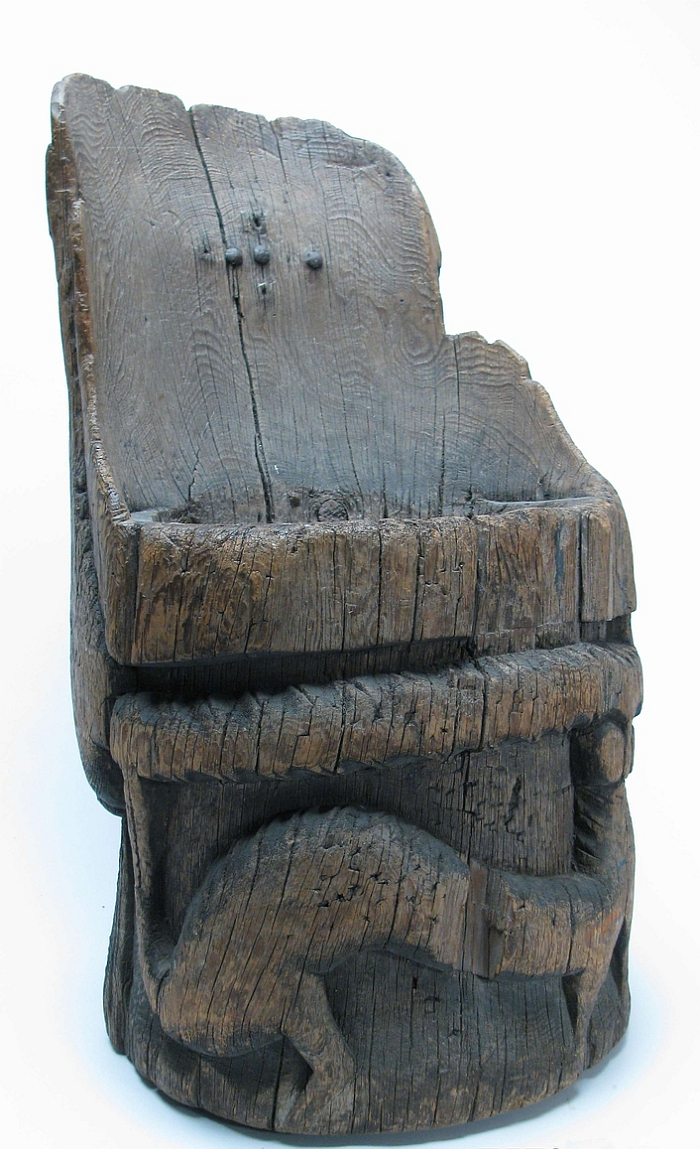
Or put another way, whereas the Etruscan/Villanovan tree trunk chairs appear to have largely vanished in the regions where they arose, that having been, as Bentini et al noted, "made exclusively for the funeral ritual and burial", had, as best we can ascertain, no existence in daily Etruscan/Villanovan life, they thus ceased to exist as objects when those funeral rituals changed, similarly in ancient Saxon where, and again as best we can ascertain, they only existed in context of funeral rituals; in Scandinavia the kubbestol/kubbstol was from the Middle Ages onwards, so after the Vikings, a regularly occurring, relatively common and geographically widespread21, seating object. Amongst the living.
And while, yes, we wouldn't expect to find intact examples of actual wooden chairs used in actual homes from early centuries CE Italy or Saxon, we would, arguably, expect to find more regular reference to them. And more examples from the Middle Ages onwards. But we don't. Or rather we do, in Scandinavia.
Which for us tends to indicate a different relationship to the object, a relationship arising from specific, local, realities, and through actual use by actual living people; and thus an argument that the kubbestol/kubbstol arose in Scandinavia independent of developments in Italy. And arguably before the Vikings.
And which, no, doesn't break the link we forged above between the amulets and Odin/Frigg, just, potentially, removes the link to the Etruscan/Villanovan cultures or perhaps better put potentially demands an adjustment of the context in which such a link exists. And for us the "why" in context of the amulets is a genuinely important question in establishing the (hi)story of the kubbestol/kubbstol, and one whose answer could help prove the "fortlöpande tradition" theory.
But we don't believe will.
Much more for us the kubbestol/kubbstol has such an inherent logic, is so obviously how you would make a chair if you didn't know how to make a chair but had a tree, that we can see no way past some unrecorded, and chairless, (proto-)Scandinavian standing in front of a tree and thinking, "What if....."
The kubbestol/kubbstol is essentially a readymade and thus one of the more fundamental approaches to design, taking that which one has and adapting it to what you need; and the most elementary of internet searches reveals dozens of contemporary individuals who have crafted a chair from a tree trunk through nothing more than a couple of swings of a chainsaw, and individuals who are probably unaware of the existence of the kubbestol/kubbstol. But who had a tree and needed and/or wanted a chair. The kubbestol/kubbstol arguably starting in a similar fashion, we imagine the early, the lost, kubbestoler/kubbstolar didn't have a fraction of the finesse and formal refinement of the versions we have today, would have been created through a couple of swings of an axe; however, as society, and craft skills, became ever more refined so to did the kubbestol/kubbstol. Evidence we have none. But then neither does anyone else. It's one of the joys of hunting vernacular furniture....
That Bernhard Salin rejected the chance option so out of hand is largely, if we follow him correctly, because of his focus on form, for all on a primacy of a perceived formal beauty, whereby the key is surely function; a focus on form, on beauty, is a contemporary understanding of furniture, centuries ago form was a lot less important, arguably thoroughly unimportant in context of furniture, function was everything, and as Louis H Sullivan famously taught us "form ever follows function. This is the law"22. Which doesn't necessarily mean that one function has but one form, but that any given function has its logical, natural, form and which arises in conjunction with that from which it is composed and its relations to its context. And also doesn't mean that a particular object has but one function, the function of a chair isn't simply aiding and abetting sitting, chairs also have a symbolic function: the Etruscan/Villanovan tree trunk chairs as a reflector of the status of the deceased; the kubbestol/kubbstol as the seat of the head of a household, as a reflector of the status of the head of a household.
Which might bring us back to Valhalla, Odin, Frigg, and the significance of the amulets.....
Does, for us, suggest a very different relationship between chair and society and culture, in ancient Italy and ancient Scandinavia, and thereby implies an independent origin.
Not least because that relationship, those relationships, continued to develop over many centuries, thus implying something more than ritual and symbolism.
Or at least initially.
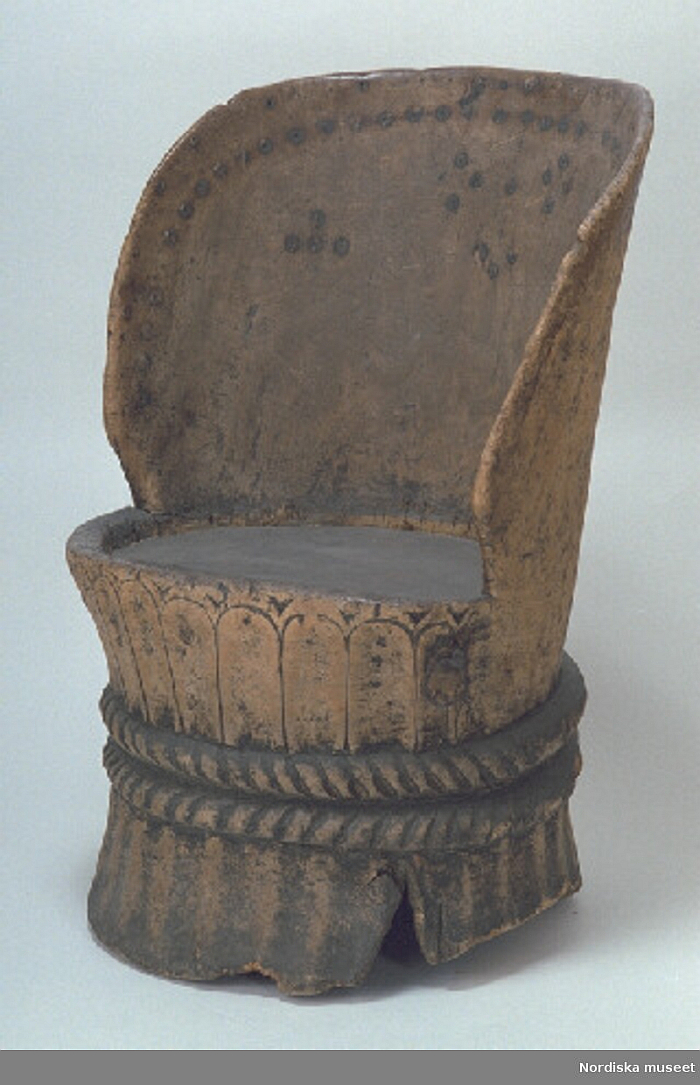
As an object of furniture the kubbestol/kubbstol is as simple as the idea of forming a tree trunk into a chair: the base uses the trunk as it is, albeit hollowed out to reduce the weight without impinging on stability; the seat, by nature of the production process, generally, being formed from an additional section of trunk and then fitted in place; the backrests being of varying height but invariably making very, very pleasing use the curve of the tree to create a backrest that naturally cups the torso, cocooning before cocooning was a thing, and which in doing so helps keep out draughts and both aids the seating comfort and underscores the invitation to sit. And is a form, and an invitation, reflected in a great many contemporary chairs, which remains a popular ideal of how a chair, for all a lounge chair, or dining chair, should be formed, should express it function. And remains so because it is innate, simple and inviting.
The (relative) unity of construction being juxtaposed by the near endless variety of decoration and ornamentation applied to the exterior.
Here is neither the time nor place for an in-depth discussion on the decoration and ornamentation of kubbestoler/kubbstolar23, save to note that one of the most engaging, stimulating, absorbing and widely repeating is the implied rope. And which in many cases represents an enormous amount of work, for all in those versions where the base is given a concave form and thereby the impression that the rope is pulling a little too tight. And a decorative ornamentation predominately found, as best we can ascertain, on Norwegian examples, and whose existence, and popular existence, we'd argue, may provide some further clues as to the origins of the kubbestol/kubbstol.
And to note that not all known kubbestol/kubbstol are decorated, a great many are undecorated thus implying that they were not a only representative object, but also an object of daily use, or perhaps increasingly became objects of daily use, and thus further tending to imply that there was little romanticised about the kubbestol/kubbstol, rather it was how chairs were made. A more detailed study than we can currently undertake being needed to ascertain if the less ornate kubbestoler/kubbstolar can be aligned with wider developments in formal and aesthetic understandings in Scandinavia.
And to note that while most all known kubbestoler/kubbstolar present themselves in their natural wood, and with their ornamentation carved into their wood, one does find ornately, decoratively, painted examples.
Including in America.
Again restrictions of time and space, and of closed libraries, preclude a detailed discussion on the kubbestol/kubbstol in America24; however, and as discussed previously in context of the settle bed, while 19th century European migrants to America didn't bring heavy objects of furniture such as the settle bed or the kubbestol/kubbstol with them, they did bring the concepts and regularly made furniture objects from their old home in their new home. And thereby not only underscoring an understanding of such objects, an understanding of the kubbestol/kubbstol, as a common place object of household furniture whose presence was expected and whose absence was noted, but also raising the kubbestol/kubbstol to a carrier of tradition, a confirmed piece of Scandinavian heritage, a link with the past, and ultimately bequeathing it a symbolism it, arguably, hadn't had since the days of Valhalla, Odin and Frigg.
And a link with the past that is largely the primary function of the kubbestoler/kubbstolar today.
With the arrival of the 20th century the kubbestol/kubbstol appears to have largely vanished from contemporary Swedish and Norwegian homes, why, we know no; alone we know that it has primarily become a museum item or something to make in folk art workshops, something that was. It's almost a Lost Furniture Design Classic. And its disappearance providing an interesting perspective for any discussion on perceived links to nature in furniture design in Scandinavia.
And a symbolism which the kubbestol/kubbstol simply doesn't need.
As an object the kubbestol/kubbstol not only has a singular character, but is an unwaveringly honest object whose inherent integrity and innate logic not only means it is as contemporary and relevant a sitting object now as it was then, but enables it to teach us an awful lot about the fundamentals of furniture, of the essence of furniture, and thus of the many, many mistakes we make today.
And is an object who, if its lives were to be unswathed, if its tales were to told, and if its (hi)story were to be unravelled, wouldn't reveal the empty core Peer Gynt famously discovers at the heart of an onion, but rather would allow not only for new, differentiated, insights into the (hi)story of Europe, but for all into the development and evolution of culture and society in Scandinavia.
For what better way to study the development and evolution of culture and society than through furniture......
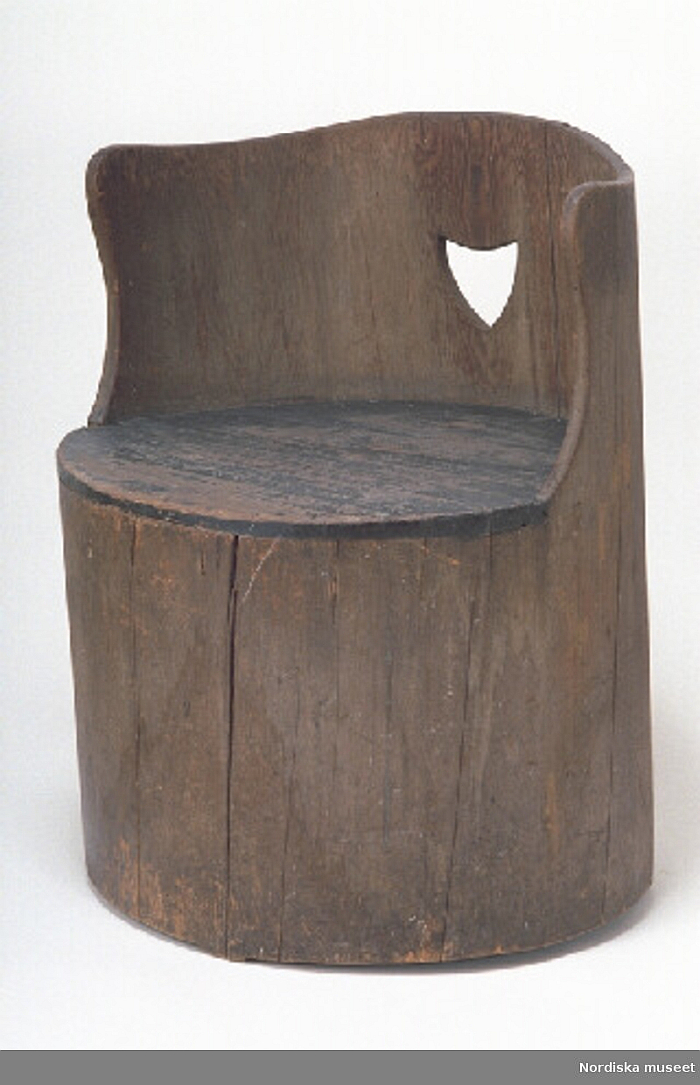
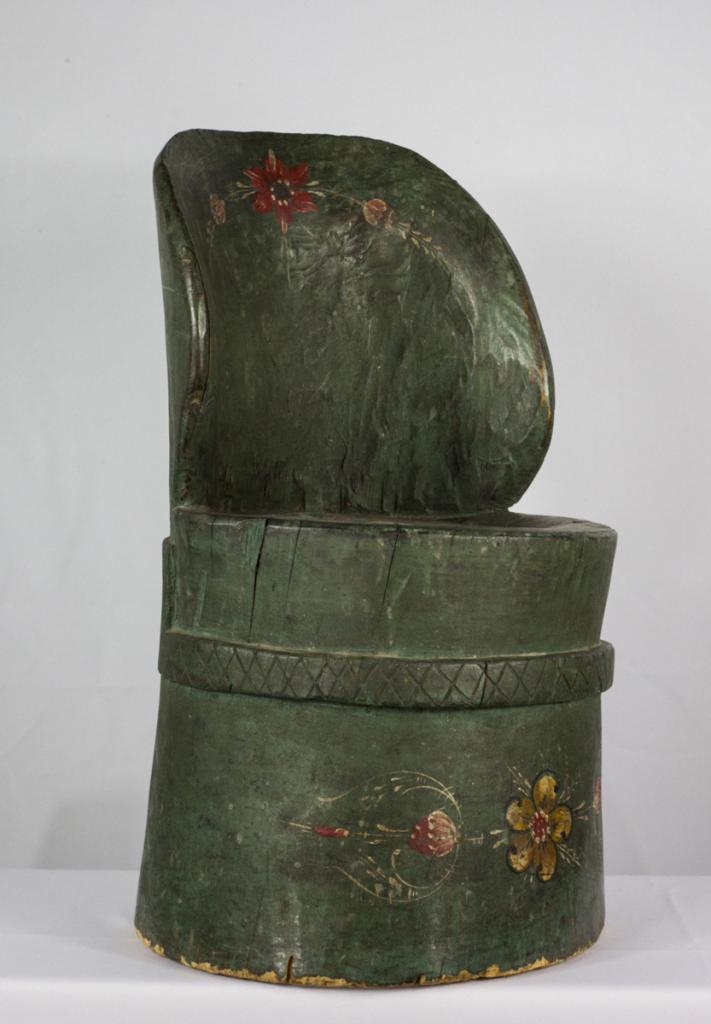
1Henrik Ibsen, Peer Gynt, 1867, Act 3 Scene 4. And, yes, it is in Danish. Although very much set in and off Norway, Peer Gynt was initially published in Danish. Which, apparently was in common use in 19th century Norway.
2Kubb and Kubbe can be translated as stump, block, chunk etc.... A piece of cut wood of variable size but not a full trunk or branch. stol is chair. stoler/stolar chairs. As we use the Norwegian/Swedish terms we also use italics. Kubb/Kubbe can also be translated as klotz, chump, etc... we'll leave you to draw your own comparison with Peer Gynt......
3Bernhard Salin, En arkeologisk bagatell, Fornvännen - Journal of Swedish Antiquarian Research, Vol 11, 1916, pages 63-75 Available via http://raa.diva-portal.org/smash/record.jsf?pid=diva2%3A1225567&dswid=-6962 (accessed 17.01.2021)
4All finds from Björkö are generally listed today as 800 - 1099 and so Salin's dating could be out, and all three might be from a much closer time period. In context of other amulets Karl Hauck noted that "even if today one cannot completely rule out the production of such a silver chair with an enthroned figure in Haithabu as a mass product" So here the similarity between the three amulets could indicate they were a mass produced item, and if so could help better explain their purpose and significance, see Hans Drescher & Karl Hauck, Götterthrone des heidnischen Nordens, Frühmittelalterliche Studien, Vol. 16, Nr 1, 1982 page 293
5The oldest mentions in Norway are more recent, and the existence is also, apparently, recorded in Denmark. We currently however cannot access all the sources we would need to discuss the subject in more detail, and so focus on the earliest evidence in Sweden. Also for reasons of readability.
6The assumption obviously here is that they are amulets, and not, for example, non-symbolic items of jewellery,. Or Monopoly pieces. Most sources seem certain they are amulets, see, for example, Hans Drescher & Karl Hauck, Götterthrone des heidnischen Nordens, Frühmittelalterliche Studien, Vol. 16, Nr 1, 1982 page 237-301 or Sven Kalmring, A new Throne-Amulet from Hedeby. First Indication for Viking-age Barrel-chairs, Danish Journal of Archaeology, Vol. 8 Nrs 1-9 2019
7The word Salin uses is "hängsmycke" which were not confident enough to translate as amulet
8Hugo Jungner, Den gotländska runbildstenen från Sanda. Om Valhallstro och hednisk begravningsritual, Fornvännen - Journal of Swedish Antiquarian Research, Vol. 25, 1930 pages 65-82 Available via http://www.diva-portal.org/smash/record.jsf?pid=diva2%3A1227332&dswid=-6962 (accessed 17.01.2021)
9Leszek Gardeła suggests a possible association with seiðr, a form of Norse shamanism. And also that the kubbestol/kubbstol may have been a chair used when spinning wool, and which is another very interesting line of inquiry, and one that could be well worth taking, see Leszek Gardeła, Into Viking Minds: Reinterpreting the Staffs of Sorcery and Unravelling "Seiđr", Viking and Medieval Scandinavia, Vol. 4, 2008, pages 45-84
10Hans Hildebrand, Antiqvariska undersökningar i Skåne. En reseberättelse, Antiqvarisk tidskrift för Sverige, Tredje Delen, 1870-1873, page 100 Available via http://runeberg.org/antiqtid/3/0005.html (accessed 17.01.2021)
11And regularly is made see, for example, Hans Drescher & Karl Hauck, Götterthrone des heidnischen Nordens, Frühmittelalterliche Studien, Vol. 16, Nr 1, 1982 or Leszek Gardeła, Into Viking Minds: Reinterpreting the Staffs of Sorcery and Unravelling "Seiđr", Viking and Medieval Scandinavia Vol. 4, 2008, pages 45-84
12Laura Bentini et al, Wooden thrones: ritual and function in Italian Iron Age, Arimnestos - Ricerche di Protostoria Mediterranea, Vol 1, 2018 pages 171-185
13 M. Torelli, Solida Sella. Archeologia del costume nella pratica degli auspici di Etruria e Roma, in Studi di protostoria in onore di Renato Peroni, Firenze 2006, pp. 684-690, quoted in ibid page 172
14Laura Bentini et al, Wooden thrones: ritual and function in Italian Iron Age, Arimnestos - Ricerche di Protostoria Mediterranea, Vol 1, 2018 pages 171-185
15See, for example, Anthony S. Tuck, The Etruscan Seated Banquet: Villanovan Ritual and Etruscan Iconography, American Journal of Archaeology, Vol. 98, No. 4, 1994, pages 617-628
16See, for example, Ingrid Strom, A Fragment of an Early Etruscan Bronze Throne in Olympia? in Signe Isager and Inge Nielsen [Eds] Proceedings of the Danish Institute at Athens III, 2000 page 70ff
17Bernhard Salin, En arkeologisk bagatell, Fornvännen - Journal of Swedish Antiquarian Research, Vol 11, 1916, pages 63-75 Available via http://raa.diva-portal.org/smash/record.jsf?pid=diva2%3A1225567&dswid=-6962 (accessed 17.01.2021)
18There are a couple of book references to the chair which we are currently unable to access, but which should allow for a much fuller understanding of the object, for all, Matthias D. Schön, Der Thron aus der Marsch, Museum Burg Bederkesa, 1995 See also, for example, Jürgen Udolph, Matthias D. Schön, Klaus Düwel, Wremen in Germanische Altertumskunde Online [https://doi.org/10.1515/GAO] The object itself is held at Museum Burg Bederkesa.
19As ever, we may have missed it, may have been looking in the wrong places, and apologies in advance if we have. However, from what we have seen and what we have read while a couple of authors have approached aspects of the subject, there has been no been concerted effort to attempt chart a history, a bigraphy, of the kubbestol/kubbstol. Yet it would appear a task well worth undertaking.
20Purchased by Artur Hazelius in 1875 in the Norwegian village of Sauland, today held by the Nordiska museet, Stockholm and which in the 1970s C-14 carbon dating placed as originating from 1460 +/- 160 years, i.e from between 1300 and 1620. See, for example, Maj Nodermann and David Damell, Nya rön i en gammal dateringsfråga. Om selbågen från Lom och kubbstolen från Sauland, RIG, Vol 64, 1981, pages 109 - 114 for details on the dating and Sune Lindqvist and Ebba Hult De Geer, Kubbstolen från Sauland, Fataburen. Nordiska museets och Skansens årsbok 1939, pages 99 - 130 for a fulsome description of the chair, and a, potential, association of the kubbestol/kubbstol with early dentistry..... The latter is available via http://www.diva-portal.org/smash/record.jsf?pid=diva2%3A1235420&dswid=-6962 (accessed 17.01.2021)
21Salin lists the kubbestol/kubbstol as being found in "In Sweden mainly in Dalsland, Värmland, Dalarna, Gestrikland and Helsingland; in Norway mainly in the interior of the country, Gudbrandsdalen, Numedalen, Hallingen, Telemarken etc, and all the way down to the coast in eastern Norway", and thus predominately southern Norway and a strip of central Sweden from the border with Norway to Bothnian Sea, and interestingly to the north of Gothenburg and Stockholm. And a distribution which may also help trace the (hi)story
22Louis H. Sullivan, The tall office building artistically considered, in Lippincott’s Monthly Magazine, Philadelphia, March 1896. And it's not a law. It's not. Its a theory. That however some mistake it as a law has lead to an awful lot of problems.
23For some examples see kubbstol @ europeana.eu and kubbestol @ europeana.eu and also kubbstol @ digitaltmuseum.se and kubbestol @ digitaltmuseum.se
24Certainly the kubbestol. While we have several sources of Norwegians making kubbestoler, we're less confident about Swedes making kubbstolar, and so, and so oft these days, we'll have to wait until the libraries are once again open. For Norwegians America see, for example, Joanna Wilson The Little Kubbestol: A View of Norwegian-American Ethnic Identity through an Autobiography of an Object Biography and on the same site you can enjoy a rocking kubbestol/kubbstol